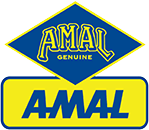Amal carburetters can be damaged by careless installation to the engine. Use the following instructions to avoid distorting your carburetters.
The flange to which the carburetter is attached must be perfectly flat and clean. Remove all traces of old gaskets and gasket cement before installation. If possible remove manifolds with uneven surfaces and restore flatness using wet and dry paper over a flat surface, or fine grinding paste on a piece of glass. Heat reducing spacers should be similarly treated to ensure flatness. Bolting the carburetter to a distorted flange or uneven spacer increases the risk of carburetter body or flange distortion.
Always remove and replace the carburetter fully assembled, with the float chamber and mixing chamber lid, throttle cable and slide components installed. This ensures maximum rigidity of the assembly while it is being installed.
Tighten the mounting nuts carefully and evenly. Nuts and spring washers should be tightened until the spring washer is just flattened. Over-tightening the nuts will over-compress the flange gaskets at the flange extremities and may warp the flange, and in extreme cases the carburetter body, causing the throttle valve to stick.
Mark 1 carburetters are not designed to bolt tightly to the intake flange and may distort if overtightened. It is only necessary to compress the O ring seal to ensure air tightness. When correctly tightened the carburetter flange and engine manifold should be no more than just touching. Nyloc nuts should always be used to mount Amal Mark 1 carburetters.
Where the thicker O rings are used, on early Monoblocs and some Mark 1 carburetters, the nuts should be tightened until the clearance between the carburetter flange and the manifold surface is no less than 0.025 inches at all points.
Ensure that throttle and choke cables are able to open and shut freely when the petrol tank is replaced on the bike. Also make sure they are not affected by moving the handlebars from side to side.





